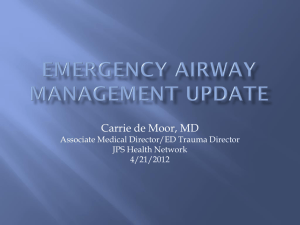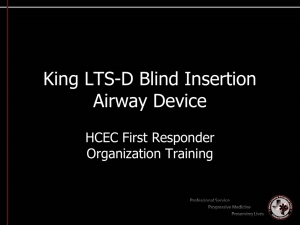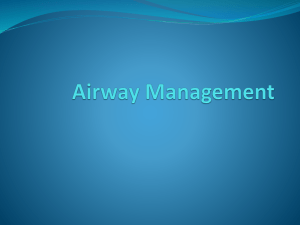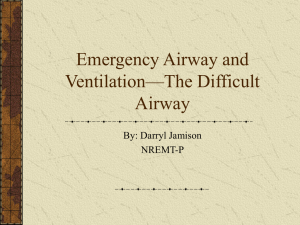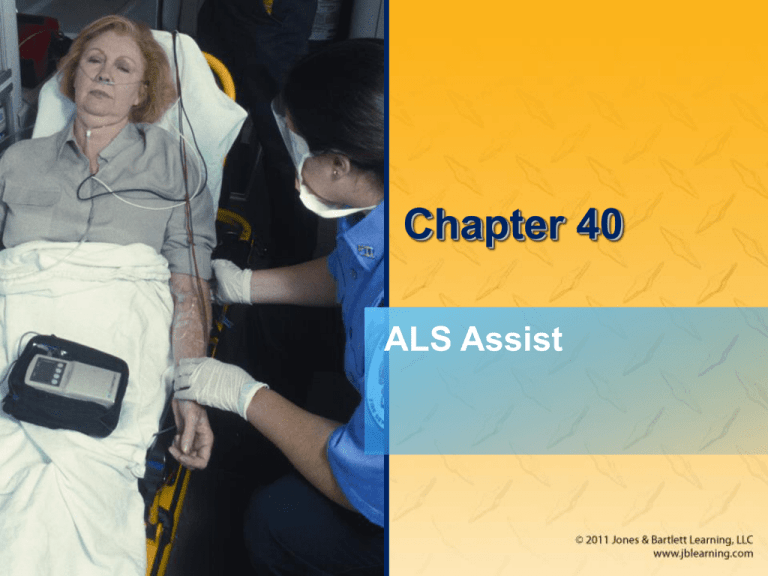
Chapter 40
ALS Assist
Introduction
• You may need to be familiar with AEMT and
paramedic skills.
• These include:
– Advanced airway techniques
– Intravenous (IV) therapy
– Cardiac monitoring
Advanced Airway Techniques
• Establishing and maintaining an airway is
the single most important EMT skill.
– Most conscious patients can maintain their own
airway.
– Other patients may require an oropharyngeal or
nasopharyngeal airway.
– Advanced airway management provides better
airway protection and ventilation.
Anatomy and Physiology of the
Airway (1 of 5)
• The respiratory system consists of all the
body structures used for breathing.
– Upper airway includes the nose, mouth, throat
(pharynx), and larynx (vocal cords).
– Lower airway includes the trachea, bronchi, and
lungs.
Anatomy and Physiology of the
Airway (2 of 5)
Anatomy and Physiology of the
Airway (3 of 5)
• The respiratory system:
– Delivers oxygen to body
– Removes carbon dioxide
• This process takes place on two levels:
– Alveolar-capillary exchange
– Capillary-cellular exchange
Anatomy and Physiology of the
Airway (4 of 5)
Anatomy and Physiology of the
Airway (5 of 5)
• Each living cell of the body requires a
regular supply of oxygen.
– Some cells, such as those in the heart, brain,
and nervous system, need a constant supply to
survive.
– Other cells can tolerate short periods without
oxygen.
Basic Airway Management
(1 of 2)
• Always assess the airway first in an injured
or ill patient.
• Open the airway.
– Use the head tilt–chin lift maneuver in a patient
with no suspected spinal injury.
– Use the jaw-thrust maneuver if there is a
possibility of spinal injury.
Basic Airway Management
(2 of 2)
• Assess the airway and evaluate the need
for suctioning to remove:
– Foreign bodies
– Liquid
– Blood
• Determine if the patient needs an airway
adjunct.
Endotracheal Intubation (1 of 2)
• Insertion of a tube into the trachea to
maintain the airway
– If done through the mouth, it is called
orotracheal intubation.
– If done through the nose, it is called
nasotracheal intubation.
– Tube passes directly through the larynx
between the vocal cords and trachea.
Endotracheal Intubation (2 of 2)
• Very effective method
• Indicated for:
– Patients who cannot protect their own airway
– Patients who need prolonged artificial
ventilation
Equipment (1 of 8)
• Assemble all the equipment.
– Laryngoscope handle and blade
– Properly sized endotracheal (ET) tube
– Stylet
– 10-mL syringe
– Water-soluble lubricant for the ET tube
– Suction unit with rigid and soft-tip catheters
Equipment (2 of 8)
• Assemble all the
equipment (cont’d).
– Magill forceps
– Stethoscope
– Commercial
securing device
– Secondary
confirmation device
Equipment (3 of 8)
• Laryngoscope
– Used to sweep the tongue out of the way and
align the airway so the vocal cords can be
visualized
• Endotracheal tubes
– Proper-sized tube for adults ranges from 7.0 to
8.5 mm
Equipment (4 of 8)
Equipment (5 of 8)
• Endotracheal tubes (cont’d)
– Use the largest-diameter ET tube that will pass
easily through the vocal cords.
– For children, use a resuscitation tape device.
– A standard 15/22-mm adapter attaches to any
ventilation device.
Equipment (6 of 8)
Equipment (7 of 8)
• Stylet
– Inserted into the
ET tube to add
rigidity and shape
during intubation
– Bend the tip to
form a gentle
curve.
– Do not insert past
Murphy’s eye.
Equipment (8 of 8)
• Syringe
– Use a 10-mL syringe to test for air leaks in the
ET tube before intubation.
• Other equipment
– A suction unit may be needed to clear
secretions or blood.
– A commercial securing device ensures that the
tube does not move.
The Sellick Maneuver
• Can be used to intubate a patient who has
no cough and/or gag reflex
• Helps reduce the chance of regurgitation
and aspiration of stomach contents
• Follow the steps in Skill Drill 40-1.
– Be sure to correctly identify anatomic
landmarks.
The Intubation Procedure (1 of 7)
• You may intubate only if authorized by offline or online medical control.
• Be sure to use standard precautions.
• An intubation attempt should not take more
than 30 seconds.
– Begins when ventilation stops and the
laryngoscope blade is inserted
– Ends when ventilation begins again
The Intubation Procedure (2 of 7)
• Intubation is a multiple-person task.
– First EMT applies and uses the AED.
– Second and third EMTs perform CPR at a ratio
of 30 compressions to 2 ventilations.
– Fourth EMT prepares and intubates the patient.
• Follow the steps in Skill Drill 40-2 to
perform orotracheal intubation.
The Intubation Procedure (3 of 7)
• You must use a secondary method of
confirming proper tube placement.
– Esophageal detector devices
– End-tidal carbon dioxide detectors
– Capnography monitors
– These devices are not 100% guaranteed.
The Intubation Procedure (4 of 7)
Source: The LIFEPAK® 15 defibrillator monitor courtesy of Physio-Control. Used with permission of Physio-Control, Inc., and according to the Material Release
Form provided by Physio-Control.
The Intubation Procedure (5 of 7)
• Primary confirmation is:
– Direct visualization of the tube passing through
the vocal cords
– Auscultating good bilateral breath sounds
– Seeing the patient’s chest rise and fall with each
ventilation
• Never let go of the ET tube until it is
secured.
The Intubation Procedure (6 of 7)
• Intubation complications
– Intubating the right main stem bronchus
– Intubating the esophagus
– Aggravating spinal injury
– Increased hypoxia
– Patient vomiting
The Intubation Procedure (7 of 7)
• Intubation complications (cont’d)
– Laryngospasm
– Trauma
– Mechanical failure
– Patient intolerant of the endotracheal tube
– Decrease in heart rate
Multilumen Airways (1 of 4)
• Advanced airways
that do not require
visualization of the
vocal cords for
placement
The Combitube
– Examples include
the Combitube and
pharyngeotracheal
lumen airway.
Multilumen Airways (2 of 4)
Multilumen Airways (3 of 4)
• Contraindications
– Conscious or semiconscious patients with a gag
reflex
– Children younger than 14 years
– Adults shorter than 5′
– Patients who have ingested a caustic substance
– Patients who have an esophageal disease
Multilumen Airways (4 of 4)
• Removing the multilumen airway
– If the patient will no longer tolerate the airway, it
should be removed.
– Remember that the patient will likely vomit when
the airway is removed, so a suction unit must be
readily available.
– Simply deflate both balloon cuffs and gently
remove the tube.
Single Lumen Airway (1 of 3)
• King LT airway
– Single lumen airway that is blindly inserted into
the esophagus
– Consists of a curved tube with ventilation ports
located between two inflatable cuffs
– Intended in patients who are taller than 4′
Single Lumen Airway (2 of 3)
Source: Courtesy of King Systems
Single Lumen Airway (3 of 3)
• Laryngeal mask
airway
– Consists of two
parts: the tube and
the mask or cuff
– After blind insertion,
the device molds
and seals itself
around the laryngeal
opening by inflation
of the mask.
Gastric Tubes (1 of 2)
• Sometimes a patient may require placement
of a tube through the nose or mouth that
extends into the stomach.
– Cardiac arrest patients
– A nasal or oral gastric tube relieves gastric
distention.
– May be used by ED staff to lavage the stomach
in cases of overdose
Gastric Tubes (2 of 2)
• Proper placement can be confirmed by:
– Aspiration of stomach contents with a syringe
– Listening with a stethoscope as air is introduced
into the tube with a syringe
– Radiograph on arrival at the ED
Continuous Positive Airway
Pressure (1 of 3)
• Used in breathing patients who are alert
and able to follow commands and have
reduced function of the alveoli due to:
– Congestive heart failure
– Chronic obstructive pulmonary disease
– Asthma
Continuous Positive Airway
Pressure (2 of 3)
• A tight-fitting mask is placed over the mouth
and nose and connected to an oxygen
source.
– Delivers flow rates of at least 50 L/min
– May be helpful in patients with severe
respiratory distress
Continuous Positive Airway
Pressure (3 of 3)
Courtesy of Respironics, Inc., Murraysville, PA. All rights reserved.
Intravenous Therapy
• Develop a routine to follow as you assemble
the appropriate equipment.
– This will help you keep track of your equipment
and the steps necessary to complete successful
IV administration.
Indications
• Many medications used by ALS crews are
given by the IV route.
• A fluid bolus may be indicated for patients
who:
– Are dehydrated because of vomiting or
excessive diarrhea
– Have experienced blood loss because of
hemorrhage
Assembling the Equipment
Choosing an IV Solution (1 of 3)
• In the prehospital setting, the choice of IV
solution is limited to:
– Isotonic crystalloids
– Normal saline
– Lactated Ringer’s solution
• D5W is often reserved for administering
medication.
Choosing an IV Solution (2 of 3)
• Each IV solution bag
is wrapped in a
protective sterile
plastic bag.
– Guaranteed to
remain sterile until
the posted expiration
date
– Once the wrap is
torn, the IV solution
has a shelf life of
24 hours.
Choosing an IV Solution (3 of 3)
• The bottom of each
bag has two ports:
– An injection port for
medication
– An access port for
connecting the
administration set
• The more common
prehospital volumes
are 1,000 mL and
500 mL.
Choosing an Administration
Set (1 of 3)
• An administration
set moves fluid
from the IV bag
into the patient’s
vascular system.
– Each set has a
piercing spike
protected by a
plastic cover.
Choosing an Administration
Set (2 of 3)
• Drip sets come in
two primary sizes.
– A microdrip set
allows 60 gtt/mL.
– A macrodrip
set allows 10 to
15 gtt/mL.
Choosing an Administration
Set (3 of 3)
• Preparing an administration set
– Verify the solution and check for clarity.
– To spike the bag with the administration set,
follow the steps in Skill Drill 40-3.
– Saline locks (buff caps) are a way to maintain
an active IV site without running fluids through
the vein.
Catheters
• Hollow, laser-sharpened needle inside a
hollow plastic tube that is inserted into a
vein
• Select the catheter size based on the:
– Need for the IV
– Condition of the patient’s veins
– Location for the IV
Starting an IV (1 of 2)
• Apply a tourniquet proximal to the site
where venipuncture is to be performed.
• When a suitable vein is identified, the area
should be cleaned.
• The needle/catheter is introduced into the
vein, the needle withdrawn and disposed of
properly, and IV tubing or lock placed.
Starting an IV (2 of 2)
• Use tape or a commercially available device
to secure the catheter.
• Always wear gloves during the procedure.
• Skill Drill 40-4 covers how to start an IV.
Securing the Line
• Tape the area so that the catheter and
tubing are securely anchored in case of a
sudden pull on the line.
• Avoid circumferential taping around any
extremity because it can act like a
constricting band and stop circulation.
Alternative IV Sites and
Techniques (1 of 2)
• Intraosseous (IO)
needles
– Used for emergency
venous access when
other IV access is
difficult or impossible
– Often patients are
experiencing a lifethreatening situation.
– Generally inserted in
the proximal tibia
Alternative IV Sites and
Techniques (2 of 2)
• External jugular IV
– Provides venous access through the external
jugular veins in the neck
– Catheter is inserted midway between the angle
of the jaw and the midclavicular line.
– Punctures can be difficult because these veins
are surrounded by a very tough, fibrous sheath.
Possible Complications of IV
Therapy
• Local reactions include problems like
infiltration and phlebitis.
• Systemic complications include allergic
reactions and circulatory overload.
Local IV Site Reactions (1 of 4)
• Infiltration
– Escape of fluid into the surrounding tissue when
the IV catheter is not in the vein
– Can cause a localized are of edema or swelling
– Stop the flow, remove the catheter, and reinsert
it at an alternative site.
Local IV Site Reactions (2 of 4)
• Phlebitis
– Inflammation of the vein
– Not usually seen in emergency prehospital
patients
– Associated with fever, tenderness, and red
streaking along the vein
Local IV Site Reactions (3 of 4)
• Occlusion
– Physical blockage of a vein or catheter
• Vein irritation
– More common with IV medication administration
and very uncommon with administration of pure
IV fluids
– Patients often complain immediately that the IV
is bothering them.
Local IV Site Reactions (4 of 4)
• Hematoma
– Accumulation of blood in the tissues
surrounding an IV site
– Result from vein perforation or catheter removal
– If a hematoma develops when IV catheter insert
is attempted, the procedure should stop.
Systemic Complications (1 of 7)
• A systemic complication can evolve from
reactions or complications associated with
IV insertion.
– Usually involve other body systems and can be
life threatening
• Allergic reactions
– True anaphylaxis is possible and must be
treated aggressively.
Systemic Complications (2 of 7)
• Allergic reactions (cont’d)
– Can be related to a person’s unexpected
sensitivity to an IV fluid or medication
– Discontinue the IV fluid and remove the
solution, maintain the airway, and monitor ABCs
and vital signs.
Systemic Complications (3 of 7)
• Air embolus
– Patients who are already ill or injured can be
adversely affected if air is introduced into the
circulatory system.
– Properly flush the IV line.
– Treat a patient by placing him or her on the left
side with the head down.
Systemic Complications (4 of 7)
• Circulatory overload
– An unmonitored IV bag can lead to circulatory
overload.
– Problems occur when the patient has cardiac,
pulmonary, or renal dysfunction.
– The most common cause in the prehospital
setting is failure to readjust the drip rate after
flushing an IV line.
Systemic Complications (5 of 7)
• Circulatory overload (cont’d)
– To treat a patient:
• Slow the IV rate to keep the vein open.
• Raise the patient’s head to ease respiratory
distress.
• Administer high-flow oxygen.
• Monitor vital signs and shortness of breath.
Systemic Complications (6 of 7)
• Vasovagal reactions
– Some patients have anxiety concerning needles
or in response to the sight of blood.
– Patients can present with anxiety, diaphoresis,
nausea, or syncopal episodes.
– Lower the head of the stretcher, administer
oxygen, and monitor vital signs.
Systemic Complications (7 of 7)
• Catheter shear
– Potential complication when starting an IV
– Could have a devastating effect on your patient
– May occur if you attempt to reinsert the needle
through the catheter after the needle has been
partially withdrawn
Troubleshooting
• Several factors influence IV flow rate.
• Perform the following checks after
completing IV administration.
– Check your administration set.
– Check the height of the IV bag.
– Check the type of catheter used.
– Check the tourniquet.
Age-Specific Considerations
(1 of 2)
• IV therapy for pediatric patients
– A child has smaller veins.
– A small-gauge catheter should be used
(22-gauge to 24-gauge).
– Volume control is important.
– Use a special type of microdrip set called a
Volutrol, which fills the large drip chamber with a
specific amount of fluid.
Age-Specific Considerations
(2 of 2)
• IV therapy for geriatric patients
– Smaller catheters may be preferable.
– The use of tape can lead to skin damage, so be
careful when taping IV catheters and tubing.
– Be careful when using macrodrips because they
can allow infusion of fluids, which may lead to
fluid overload.
Cardiac Monitoring
• 12-lead ECG can help in the early
identification of an acute myocardial
infarction (AMI).
– The interpretation of cardiac rhythm may not be
an EMT skill.
– However, it is helpful to be able to place
electrodes and leads.
Electrical Conduction System
(1 of 2)
• Network of specialized tissue capable of
conducting electrical current throughout the
heart
• Contains:
– Sinoatrial (SA) node
– Three intermodal pathways
– Atrioventricular (AV) node
– Bundle of His
– Right and left bundle branches
Electrical Conduction System
(2 of 2)
Electrodes and Waves
• The ECG electrodes pick up the electrical
activity of the heart, and the ECG machine
converts them to waves.
• The way an ECG tracing looks depends on
where the lead is placed.
The ECG Complex (1 of 3)
• One complex represents one beat in the
heart.
• The complex consists of several waves: the
P, QRS, and T waves.
• A segment is a specific portion of the
complex.
The ECG Complex (2 of 3)
The ECG Complex (3 of 3)
• An interval is the distance, measured in
time, occurring between two cardiac events.
– The time between the beginning of the P wave
and the beginning of the QRS complex is known
as the P-R interval.
ECG Paper
• The paper on which an ECG is recorded
contains a grid.
– Each little box represents 1/25 of a second, or
0.04 second.
– Each bigger box is composed of five smaller
boxes, or 0.20 second.
– Five big boxes equal 1 second.
Normal Sinus Rhythm (1 of 2)
• Sinus rhythm is a rhythm in which the SA
node acts as the pacemaker.
• With normal sinus rhythm:
– All of the P waves should be the same.
– The heart rate should be between 60 and
100 beats/min.
Normal Sinus Rhythm (2 of 2)
The Formation of the ECG (1 of 3)
• Production of the heart’s rhythm is a
continuous process, with no actual period of
rest or inactivity.
• If the heart is functioning normally, the
process will repeat over and over
continuously.
The Formation of the ECG (2 of 3)
The Formation of the ECG (3 of 3)
Arrhythmias (1 of 5)
• Abnormal rhythm of the heart
• Sinus bradycardia
– Consistent P waves, consistent P-R intervals,
regular heart rate less than 60 beats/min
Source: From Arrhythmia Recognition: The Art of Interpretation, courtesy of Tomas B. Garcia, MD.
Arrhythmias (2 of 5)
• Sinus tachycardia
– Consistent P waves, consistent P-R intervals,
regular heart rate more than 100 beats/min
– May cause a decrease in cardiac output
Source: From Arrhythmia Recognition: The Art of Interpretation, courtesy of Tomas B. Garcia, MD.
Arrhythmias (3 of 5)
• Ventricular tachycardia
– Presence of three or more abnormal ventricular
complexes in a row with a rate of more than 100
beats/min
– Very regular rhythm
Source: From Arrhythmia Recognition: The Art of Interpretation, courtesy of Tomas B. Garcia, MD.
Arrhythmias (4 of 5)
• Ventricular fibrillation
– Rapid, completely disorganized ventricular rhythm with
chaotic characteristics
– Undulations of varying shapes and sizes; no specific
pattern; no discernable P, QRS, or T waves
– No organized beating of the heart
Source: From Arrhythmia Recognition: The Art of Interpretation, courtesy of Tomas B. Garcia, MD.
Arrhythmias (5 of 5)
• Asystole
– Complete absence of any electrical cardiac
activity
– Patient is clinically dead at this point.
Source: From Arrhythmia Recognition: The Art of Interpretation, courtesy of Tomas B. Garcia, MD.
Assisting With Cardiac
Monitoring
• You may have a 4-lead ECG or a 12-lead
ECG system.
• New cardiac monitors include several new
features using modern technology.
• They are compact, light, and portable and
combine defibrillation and monitoring
capabilities.
Lead Placement (1 of 5)
• A 4-lead ECG uses four leads, which are
electrodes attached to wires.
• The four leads are called the limb leads.
– White lead on the right shoulder or arm
– Black lead on the left shoulder or arm
– Green lead on the right low abdomen/leg
– Red lead on the left low abdomen/leg
Lead Placement (2 of 5)
• It does not matter
where the leads
are placed on the
limbs, as long as
all four are at least
10 cm from the
heart.
Lead Placement (3 of 5)
• For the 12-lead ECG, electrodes are placed
as a 4-lead placement as well as in very
specific locations on the chest.
– V1 and V2 on each side of the sternum
– V4 at the midclavicular line
– V3 between V2 and V4
– V5 at the anterior axillary line, and V6 in the
midaxillary line
Lead Placement
(4 of 5)
Lead Placement (5 of 5)
• It is very important to have direct skin
contact when obtaining an ECG.
– If the skin is wet or oily, wipe and clean the skin
thoroughly.
– If the skin is hairy, use a razor.
• Advantages of 12-lead monitoring
– Early identification of acute ischemia
– Accurate identification of arrhythmias
ST-Segment Elevation
Myocardial Infarction (STEMI)
• Specific type of myocardial infarction in
which the ST segment of the cardiac cycle is
elevated
• Treatable by techniques that rapidly restore
perfusion to the coronary arteries
– “Time is muscle.”
Summary (1 of 3)
• There may be cases in which an EMT may
find it necessary to be familiar with skills
normally practiced at the AEMT and
paramedic level. These skills include
advanced airway techniques, IV therapy,
and cardiac monitoring.
Summary (2 of 3)
• An advanced airway technique is
endotracheal intubation, the insertion of a
tube into the trachea to maintain the airway.
• Additional advanced airway care devices
include the Combitube, pharyngeotracheal
lumen airway, the King LT, and the laryngeal
mask airway.
Summary (3 of 3)
• IV therapy is used to replace fluids in a
patient with shock or to administer
medications.
• Cardiac monitoring with an ECG is an
advanced skill that the EMT may provide in
assistance to the AEMT or paramedic.





